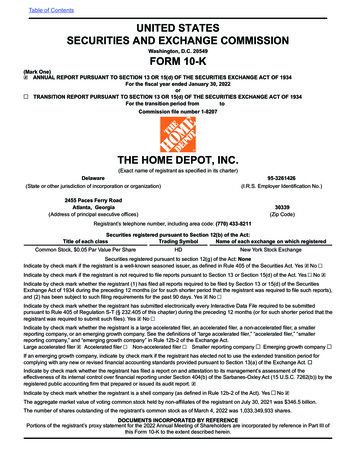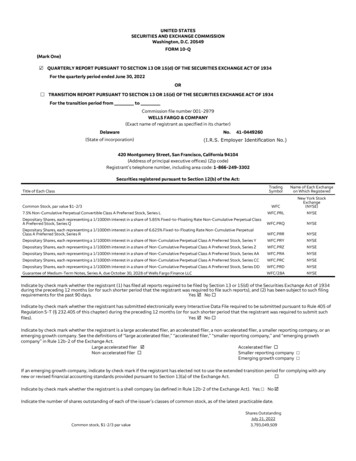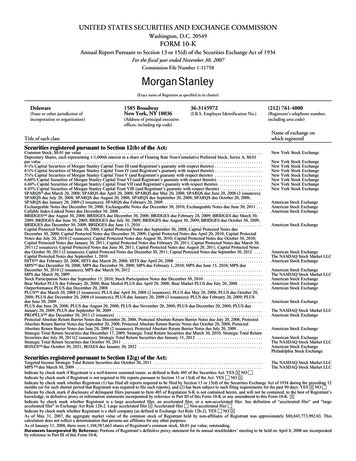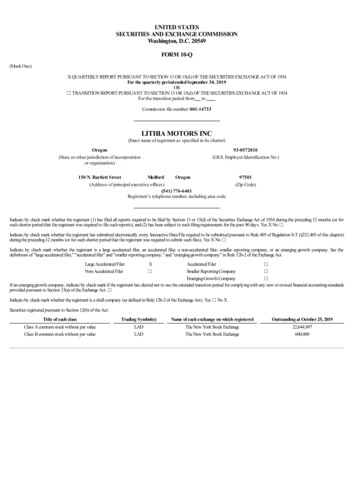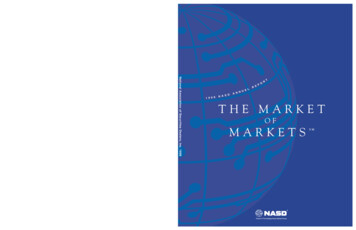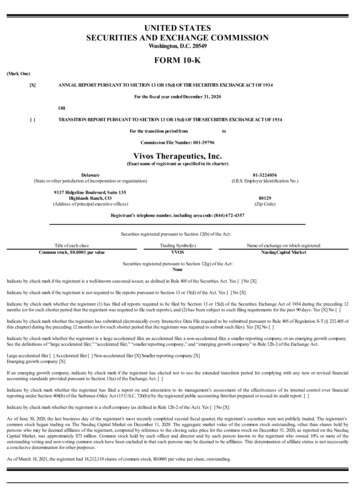
Transcription
UNITED STATESSECURITIES AND EXCHANGE COMMISSIONWashington, D.C. 20549FORM 10-K(Mark One)[X]ANNUAL REPORT PURSUANT TO SECTION 13 OR 15(d) OF THE SECURITIES EXCHANGE ACT OF 1934For the fiscal year ended December 31, 2020OR[]TRANSITION REPORT PURSUANT TO SECTION 13 OR 15(d) OF THE SECURITIES EXCHANGE ACT OF 1934For the transition period fromtoCommission File Number: 001-39796Vivos Therapeutics, Inc.(Exact name of registrant as specified in its charter)Delaware(State or other jurisdiction of incorporation or organization)81-3224056(I.R.S. Employer Identification No.)9137 Ridgeline Boulevard, Suite 135Highlands Ranch, CO(Address of principal executive offices)80129(Zip Code)Registrant’s telephone number, including area code: (844) 672-4357Securities registered pursuant to Section 12(b) of the Act:Title of each classCommon stock, 0.0001 par valueTrading Symbol(s)VVOSName of exchange on which registeredNasdaq Capital MarketSecurities registered pursuant to Section 12(g) of the Act:NoneIndicate by check mark if the registrant is a well-known seasoned issuer, as defined in Rule 405 of the Securities Act. Yes [ ] No [X]Indicate by check mark if the registrant is not required to file reports pursuant to Section 13 or 15(d) of the Act. Yes [ ] No [X]Indicate by check mark whether the registrant (1) has filed all reports required to be filed by Section 13 or 15(d) of the Securities Exchange Act of 1934 during the preceding 12months (or for such shorter period that the registrant was required to file such reports), and (2) has been subject to such filing requirements for the past 90 days. Yes [X] No [ ]Indicate by check mark whether the registrant has submitted electronically every Interactive Data File required to be submitted pursuant to Rule 405 of Regulation S-T (§ 232.405 ofthis chapter) during the preceding 12 months (or for such shorter period that the registrant was required to submit such files). Yes [X] No [ ]Indicate by check mark whether the registrant is a large accelerated filer, an accelerated filer, a non-accelerated filer, a smaller reporting company, or an emerging growth company.See the definitions of “large accelerated filer,” “accelerated filer,” “smaller reporting company,” and “emerging growth company” in Rule 12b-2 of the Exchange Act.Large accelerated filer [ ] Accelerated filer [ ] Non-accelerated filer [X] Smaller reporting company [X]Emerging growth company [X]If an emerging growth company, indicate by check mark if the registrant has elected not to use the extended transition period for complying with any new or revised financialaccounting standards provided pursuant to Section 13(a) of the Exchange Act. [ ]Indicate by check mark whether the registrant has filed a report on and attestation to its management’s assessment of the effectiveness of its internal control over financialreporting under Section 404(b) of the Sarbanes-Oxley Act (15 U.S.C. 726(b)) by the registered public accounting firm that prepared or issued its audit report. [ ]Indicate by check mark whether the registrant is a shell company (as defined in Rule 12b-2 of the Act). Yes [ ] No [X]As of June 30, 2020, the last business day of the registrant’s most recently completed second fiscal quarter, the registrant’s securities were not publicly traded. The registrant’scommon stock began trading on The Nasdaq Capital Market on December 11, 2020. The aggregate market value of the common stock outstanding, other than shares held bypersons who may be deemed affiliates of the registrant, computed by reference to the closing sales price for the common stock on December 31, 2020, as reported on the NasdaqCapital Market, was approximately 73 million. Common stock held by each officer and director and by each person known to the registrant who owned 10% or more of theoutstanding voting and non-voting common stock have been excluded in that such persons may be deemed to be affiliates. This determination of affiliate status is not necessarilya conclusive determination for other purposes.As of March 18, 2021, the registrant had 18,212,119 shares of common stock, 0.0001 par value per share, outstanding.
TABLE OF CONTENTSPageCautionary Note Regarding Forward-Looking StatementsSummary of Material Risks Associated with our BusinessItem 1.Item 1A.Item 1B.Item 2.Item 3.Item 4.PART IBusinessRisk FactorsUnresolved Staff CommentsPropertiesLegal ProceedingsMine Safety Disclosures12851515151Item 5.Item 6.Item 7.Item 7A.Item 8.Item 9.Item 9A.Item 9B.PART IIMarket for Registrant’s Common Equity, Related Stockholder Matters and Issuer Purchases of Equity SecuritiesSelected Financial DataManagement’s Discussion and Analysis of Financial Condition and Results of OperationsQuantitative and Qualitative Disclosures About Market RiskFinancial Statements and Supplementary DataChanges in and Disagreements With Accountants on Accounting and Financial DisclosureControls and ProceduresOther Information5252536162636363Item 10.Item 11.Item 12.Item 13.Item 14.PART IIIDirectors, Executive Officers and Corporate GovernanceExecutive CompensationSecurity Ownership of Certain Beneficial Owners and Management and Related Stockholder MattersCertain Relationships and Related TransactionsPrincipal Accountant Fees and Services6470747578Item 15.Item 16.PART IVExhibits, Financial Statement SchedulesForm 10-K Summary7979Signatures80CAUTIONARY NOTE REGARDING FORWARD-LOOKING STATEMENTSThis Annual Report on Form 10-K contains forward-looking statements that reflect our current expectations and views of future events. The forward-looking statementsare contained principally in the sections entitled “Risk Factors” and “Management’s Discussion and Analysis of Financial Condition and Results of Operations.” Readers arecautioned that known and unknown risks, uncertainties and other factors, including those over which we may have no control and others listed in the “Risk Factors” section ofthis Annual Report on Form 10-K, may cause our actual results, performance or achievements to be materially different from those expressed or implied by the forward-lookingstatements.You can identify some of these forward-looking statements by words or phrases such as “may,” “will,” “expect,” “anticipate,” “aim,” “estimate,” “intend,” “plan,”“believe,” “is/are likely to,” “potential,” “continue” or other similar expressions. We have based these forward-looking statements largely on our current expectations andprojections about future events that we believe may affect our financial condition, results of operations, business strategy and financial needs. These forward-looking statementsinclude statements relating to: our ability to formulate and implement our business plan, including the recruitment of dentists to enroll in our Vivos Integrated Practice (VIP) program and utilizethe Vivos System; the understanding and adoption by dentists and other healthcare professionals of the Vivos System as a treatment for mild-to-moderate OSA; our expectations concerning the effectiveness of treatment using the Vivos System and patient relapse after completion of treatment; the potential financial benefits to VIP dentists from treating patients with the Vivos System; our potential profit margin from enrollment of VIPs and sales of the Vivos System appliances; our ability to property train VIPs in the use of the Vivos System and other services we offer in their dental practices; our ability to implement effective sales, marketing and strategic initiatives to drive revenue growth (including, for example, our Medical Integration Division andVivoScore home sleep apnea test); the viability of our current intellectual property; acceptance by the marketplace of the products and services that we market; government regulations and our ability to comply with government regulations; our ability to retain key employees; adverse changes in general market conditions for medical devices such as the Vivos System; our ability to generate cash flow and profitability and continue as a going concern;
our future financing plans; and our ability to adapt to changes in market conditions (including as a result of the COVID-19 pandemic) which could impair our operations and financialperformance.These forward-looking statements involve numerous risks and uncertainties. Although we believe that our expectations expressed in these forward-looking statements arereasonable, our expectations may later be found to be incorrect. Our actual results of operations or the results of other matters that we anticipate herein could be materially differentfrom our expectations. Important risks and factors that could cause our actual results to be materially different from our expectations are generally set forth in “Risk Factors,”“Management’s Discussion and Analysis of Financial Condition and Results of Operations,” “Business,” “Regulation” and other sections in this Annual Report on Form 10-K.You should thoroughly read this Annual Report on Form 10-K and the documents that we refer to with the understanding that our actual future results may be materially differentfrom and worse than what we expect. We qualify all of our forward-looking statements by these cautionary statements.The forward-looking statements made in this Annual Report on Form 10-K relate only to events or information as of the date on which the statements are made in thisAnnual Report on Form 10-K. Except as required by law, we undertake no obligation to update or revise publicly any forward-looking statements, whether as a result of newinformation, future events or otherwise, after the date on which the statements are made or to reflect the occurrence of unanticipated events. You should read this Annual Reporton Form 10-K and the documents that we refer to in this Annual Report on Form 10-K and have filed as exhibits to this Annual Report on Form 10-K, completely and with theunderstanding that our actual future results may be materially different from what we expect.SUMMARY OF MATERIAL RISKS ASSOCIATED WITH OUR BUSINESSThe following is a summary of certain risks, uncertainties and other factors related to our company. These do not represent all of the risks we face. You shouldcarefully consider all of the risk factors presented in “Item 1A. Risk Factors” and all other information contained in this Report including the financial statements in order to amore complete picture of the risk factors we face.Risks Related to Our Business and Industry Our business has a limited operating history on which you can evaluate our past performance and future prospects. We have a history of operating losses and may never achieve cash flow positive or profitable results of operations. We will need to raise additional capital to fund and grow our business. Such funding, even if obtained, could result in substantial dilution or significant debtservice obligations. We may not be able to obtain additional capital on commercially reasonable terms in a timely manner, which could adversely affect ourliquidity, financial position, and ability to continue operations. We have identified a material weakness in our internal control over financial reporting. Substantial portion of our future revenue is from sales of a single product (the Vivos System), which leaves us reliant on the commercial viability of the VivosSystem. Our future operating results may vary significantly from quarter to quarter, which may adversely affect the price of our common stock. We may not be able to successfully implement our growth strategies for our VIPs, which could harm our business, financial condition and results of operations. Further clinical studies of our Vivos System may adversely impact our ability to generate revenue if they do not demonstrate that the Vivos System is effectivefor new indications. Our business and results of operations may be impacted by the extent to which patients using the Vivos System achieve adequate levels of third-party insurancereimbursement. Our products and third-party contract manufacturing activities are subject to governmental regulation that could prevent us from selling our Vivos System orintroducing new and/or improved products in the United States or internationally. We face significant competition in the market for treating sleep breathing disorders, and we may be unable to manage competitive pressures. We may not be able to protect our patents and proprietary technology and may become subject to intellectual property claims or litigation. We face the risk of product liability claims that could be expensive, divert management’s attention and harm our reputation and business. We may not be able tomaintain adequate product liability insurance. If we are unable to comply, or have not fully complied, with federal and state healthcare fraud and abuse laws, false claims laws, health information privacy andsecurity laws, and other healthcare laws and regulations, we could face substantial penalties. The misuse or off-label use of the Vivos System could result in injuries that lead to product liability suits or result in costly investigations, fines or sanctions byregulatory bodies if we are deemed to have engaged in the promotion of these uses, any of which could be costly to our business. We may pursue acquisitions of complementary businesses or technologies, which could divert the attention of management and which may not be integratedsuccessfully into our existing business.Risks Related to Our Products and Regulation The loss of access to our Vivos System technology would terminate or delay the further development of our products, injure our reputation or force us to payhigher fees. Our failure to obtain government approvals, or to comply with ongoing governmental regulations relating to our technologies and products, could delay or limitintroduction of our products and result in failure to achieve revenue or maintain our ongoing business. We cannot assure that we will be able to complete any required clinical trial programs successfully within any specific time period, and if such clinical trials take
longer to complete than we project, our ability to execute our current business strategy will be adversely affected. Modifications to the Vivos System may require additional FDA approvals which, if not obtained, could force us to cease marketing and/or recall the modifieddevice until we obtain new approvals. We are subject to inspection and market surveillance by the FDA to determine compliance with regulatory requirements. If the FDA finds that we have failed tocomply, the agency can institute a wide variety of enforcement actions which may materially affect our business operations. Treatment with the Vivos System has only been available for a relatively limited time, and we do not know whether there will be significant post-treatmentregression or relapse. Our new Medical Integration Division business line may implicate federal and state laws involving the practice of medicine and related anti-kickback and similarlaws.Risks Related to Our Securities Generally The market for our common stock is new and may not develop to provide you with adequate liquidity. The market price of our common stock may be highly volatile resulting in substantial losses for investors. There is a risk of significant future sales by our stockholders that are currently subject to lock-up agreements which expire in June 2021. Such sales could causethe price of our stock price to fall considerably and may adversely impact our ability to raise funds in new stock offerings. Other future sales of other shares ofour common stock could have a similar adverse effect on us. Our failure to meet the continuing listing requirements of The Nasdaq Capital Market could result in a de-listing of our securities. Our officers and directors may have the ability to exert significant influence over our affairs, including the outcome of matters requiring stockholder approval.PART IItem 1. BusinessOverviewWe are a medical technology company focused on the development and commercialization of innovative treatment alternatives for patients with sleep disorderedbreathing (SDB), including mild-to-moderate obstructive sleep apnea (OSA). We believe our products and technology represent a significant improvement in the treatment of mildto-moderate OSA versus other treatments such as continuous positive airway pressure (or CPAP) or palliative oral appliance therapies. We call our alternative and advancedtreatment the Vivos System.The Vivos SystemThe Vivos System is an advanced therapeutic protocol, which combines the use of customized oral appliance specifications developed by Vivos and prescribed byspecially trained dentists in cooperation with their medical colleagues. We believe the Vivos System technology represents the first non-surgical, non-invasive and cost-effectivetreatment for people with mild-to-moderate OSA. Combining technologies and protocols that alter the size, shape and position of the tissues of a patient’s upper airway, the VivosSystem opens airway space and can significantly reduce symptoms and conditions associated with mild-to-moderate OSA. Published studies have shown that using ourcustomized appliances and clinical protocols led to significantly lower Apnea Hypopnea Index scores and improve other conditions associated with OSA. Our patented oralappliances have proven effective (within the scope of the U.S. Food and Drug Administration (or FDA) cleared uses) in over 15,000 patients treated worldwide by more than 1,200trained dentists.The Vivos System consists of combination of our patented oral appliance (the mRNA appliance ) with multi-disciplinary and proprietary clinical treatment protocols thathas 510(k) clearance from the FDA as a Class II medical device for the treatment of snoring, mild-to-moderate OSA and SDB. We also market a specially designed and patentedFDA Class I customized oral appliance (DNA appliance ) and a number of preformed pediatric oral appliances, which we call the Vivos Guides. For the treatment of mild-tomoderate OSA, the Vivos System and other Vivos products are typically delivered to patients by dentists specially trained to use the Vivos System to address certain craniofacialand morphological conditions commonly associated with SDB and mild-to-moderate OSA.Vivos DNA applianceVivos mRNA applianceSleep Apnea and the Role of Dentists in TreatmentThe House of Delegates of the American Dental Association in 2017 adopted a policy statement describing the important role dentists can play in helping identify
patients at greater risk of sleep related breathing disorders. By focusing our business model around dentists, we fulfill this role by training dentists and providing the support touse the Vivos System with their patients that suffer from mild-to-moderate OSA. Our program to train dentists and offer them other value-added services as described below iscalled the Vivos Integrated Practice (VIP) program. The VIP program provides dentists with a strong economic incentive to provide this treatment and prescribe the VivosSystem, together with practice support services.Sleep apnea is a serious and chronic disease that negatively impacts a patient’s sleep, health and quality of life. According to a 2019 article published in Chest Physician,it is estimated that OSA afflicts 54 million adults in the U.S. alone, and according to a 2016 report by Frost & Sullivan, OSA has an annual societal cost of over 149.6 billion.According to the study “Global Prevalence of Obstructive Sleep Apnea (OSA)” conducted by an international panel of leading researchers, nearly 1 billion people worldwidehave sleep apnea.1The Vivos System is estimated to be effective in approximately 80% of cases of obstructive sleep apnea. Approximately 1 billion people globally suffer from OSA, and asmany as 80% remain undiagnosed. Research has shown that when left untreated, OSA increases the risk of comorbidities, such as high blood pressure, heart failure, stroke,diabetes, dementia and other debilitating, life-threatening diseases.Obstructive sleep apnea can range from mild to severe, based on a measurement system called the apnea-hypopnea index (AHI). The AHI is an index of the number ofpartial or complete airway blockages lasting 10 seconds or longer that a patient experiences in an hour. Studies have shown that the patented and proprietary technologies andprotocols incorporated into the Vivos System technology alter the size, shape and position of the tissues that comprise the human airway. In 17 published, peer-reviewed studies(on which our founder and Chief Medical Officer was an author) that examined the impact of our technologies and protocols on the AHI scores of patients with varying degrees ofOSA, patient AHI scores were reduced from a low of 38% to a high of 98.6%, with the mean AHI reduction shown in such studies being 67.4%. The results from published casereports and articles, together with patient-reported outcomes, have shown that our Vivos System therapy provides a significant reduction in the severity of patients’ OSA (asmeasured by industry standard indices such as the AHI among others), improvement in sleep-related quality of life, reduction in snoring, as well as a high patient compliance ratesand a strong safety profile.The treatment by a dentist of SBD and mild-to-moderate OSA with the Vivos System follows a required diagnosis of these conditions (typically through the use of either apolysomnogram (or PSG) or home sleep apnea test (or HSAT) by a medical doctor which is often provided by the sleep test provider.VivoScoreTM , Powered by SleepImageIn February 2021, we launched VivoScoreTM Powered by SleepImage , an FDA cleared diagnostic technology for home sleep apnea testing featuring what we believe tobe significant commercial advantages over existing HSAT products and technologies in the market. We believe VivoScore may enable healthcare providers to more efficientlyscreen, diagnose and initiate treatment for OSA in their patients which could result in more patients being treated with our Vivos System. While we anticipate increased revenuefrom VivoScore due to an expected increase in total patients tested and a corresponding increase in patient enrollment in Vivos System treatment, in arriving at this conclusion, weare relying on the results of a pilot test we conducted and other feedback from VIPs, which may or may not prove reliable on a broader scale.VivoScore is a comprehensive home sleep apnea test that utilizes proprietary cardiopulmonary coupling technology developed by MyCardio LLC d/b/a SleepImage(“SleepImage”). VivoScore consists of a single-sensor ring recorder worn on the finger that works with a mobile phone application which facilitates a seamless data capture andupload and proprietary cloud-based algorithms to evaluate sleep quality and clinically diagnose sleep apnea. VivoScore test results have been shown to be comparable withovernight in-lab PSG tests. VivoScore creates comprehensive proprietary sleep quality measures, such as the Sleep Quality Index (or SQI), that go beyond a mere clinical diagnosisfor sleep apnea to more effectively manage treatment benefit and improve patient outcomes. With no consumables required, per test costs are significantly reduced, which isexpected to allow for broad distribution and multi-night sleep evaluations using VivoScore that are often required by insurance carriers.The SleepImage System, which is the underlining technology for VivoScore, is FDA cleared for the purpose of evaluating sleep quality and to diagnose and manage sleepdisordered breathing in both children and adults and may eliminate access and cost hurdles that may exist with other competing HSAT technology. Current estimates show that80% of sleep apnea sufferers remain undiagnosed and untreated, creating a pressing need for an easy-to-use, clinical grade, low-cost HSAT for patients of all ages.We are bringing VivoScore to market under a Licensing, Distribution, and Marketing agreement with SleepImage. This agreement is exclusive to our company with respectto white labeling of the VivoScore brand to the sleep dentistry market in the United States and Canada. Our agreement with SleepImage has an initial term of two (2) years and issubject to automatic one (1) year extensions, subject to the right of the parties to terminate the agreement prior to an extension. Either party also has the right to terminate theagreement (subject to applicable notice and cure periods) for customary matters such as breach of the Agreement or bankruptcy of a party. SleepImage also has the right toterminate the agreement under certain other circumstances, including a change of control of our company.Our MissionOur mission is to rid the world of OSA. We believe we are well-positioned with what we consider to be a disruptive technology in our Vivos System aimed at treatingmild-to-moderate OSA, with a clear first-mover strategy in penetrating the dental market as a means of treating OSA, compelling economics at each level of the delivery chain, and atalented team of experienced professionals who are passionate about what we do and driven to deliver results.Our Market OpportunityEstimates from publicly available information vary as to the extent of obstructive sleep apnea in the United States, but we believe the market is significant. According to a2010 publicly available analysis from researchers at the Harvard Medical School Division of Sleep Medicine, mild obstructive sleep apnea is defined by an AHI between 5 and 15and has a prevalence of 8-11% of the adult population in the United States. A 2004 study published in the Journal of the American Medical Association stated the prevalence ofmild obstructive sleep apnea is one in five adults. Based on our analysis of the available public information, we estimate that approximately 15% of the adult population in theUnited States and Canada suffers from mild-to-moderate OSA. Based on the estimated total adult population of 284 million in the United States and Canada, we believe the totaladdressable United States and Canadian market is approximately 43 million adults. Our estimates set forth below relating to the intended uses of the Vivos System are also based inpart upon data found in the study Oral Appliance Treatment for Obstructive Sleep Apnea: An Update, published publicly by the National Institutes of Health in 2014. Targetedtreatment projections identified by this method of sleep titration were found to result in effective treatment in 87% of patients predicted to be successfully treated of OSA in aninitial study. To be conservative and based on available data and our internal market analysis, we estimate that over 80% of individuals diagnosed with OSA in the North Americanaddressable market may be candidates for the Vivos System, leaving us with a total addressable consumer market of over 43.2 million adults.2We currently charge clinicians an average sales price of approximately 1,600 per adult case for the Vivos System. There are approximately 160,000 qualified generaldentists in the United States and Canada who could potentially offer the Vivos System to their patients. Based on the addressable US and Canadian consumer market describedabove and average sales price, we believe the addressable consumer market for adults in the United States and Canada is approximately 69 billion.In addition, another published study, titled “Global Prevalence of Obstructive Sleep Apnea (OSA),” conducted by an international panel of leading researchers in 2007,reported that nearly 1 billion people worldwide have sleep apnea. Accordingly, we believe there is a substantial market opportunity for us outside the United States and Canada.
Our Treatment Alternative for OSA – the Vivos SystemThe Vivos System is a non-invasive, non-surgical, non-pharmaceutical, multi-disciplinary treatment modality for the treatment of mild to moderate OSA. The proprietaryand virtually painless Vivos System enhances and increases the upper airway and offers patients what we believe to be an effective treatment alternative based on clinicalretrospective data showing that some patients diagnosed with mild-to-moderate OSA, snoring and SDB symptoms are improving. Based on VIP and patient feedback we havereceived, we believe initial therapeutic benefits from using the device are often achieved relatively quickly (in days or weeks) and final clinical results are typically achieved in 12 to24 months), all at a relatively low cost to consumers ranging between 7,000 and 10,000 for adults and 3,500 to 6,000 for children (costs vary by provider) when compared toother options such as surgery.We believe that the Vivos System alters the size, shape and position of the tissues that surround and comprise the functional space known as the upper airway. Thisbelief is based on retrospective raw data with validated before and after sleep studies and Cone Beam Computerized Tomography (CBCT) scans from treating clinicians and patienttestimony. As the Vivos System treatment process progresses, the airway expands, with many patients reporting a significant reduction of their mild-to-moderate OSA symptoms.Our primary product used in the Vivos System is the mRNA appliance , a specifically designed, custom oral appliance that is worn primarily in the evening hours and overnightand is available for adults. The total treatment time can range from 12 to 24 months with 18 months being the approximate mean treatment time. Our appliances require periodicadjustments some of which can be performed by the patient and others that are typically rendered at the dental office where treatment was initiated.Patients who undergo treatment in the Vivos System will typically receive a customized mRNA appliance fitted to both the upper and lower arches. Alternatively, the VIPmay prescribe an upper arch DNA appliance with the possibility of adding a lower ar
securities and exchange commission washington, d.c. 20549 form 10-k (mark one) [x] annual report pursuant to section 13 or 15(d) of the securities exchange act of 1934 for the fiscal year ended december 31, 2020 or [ ] transition report pursuant to section 13 or 15(d) of the securities exchange act of 1934
